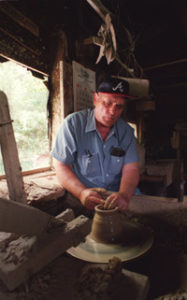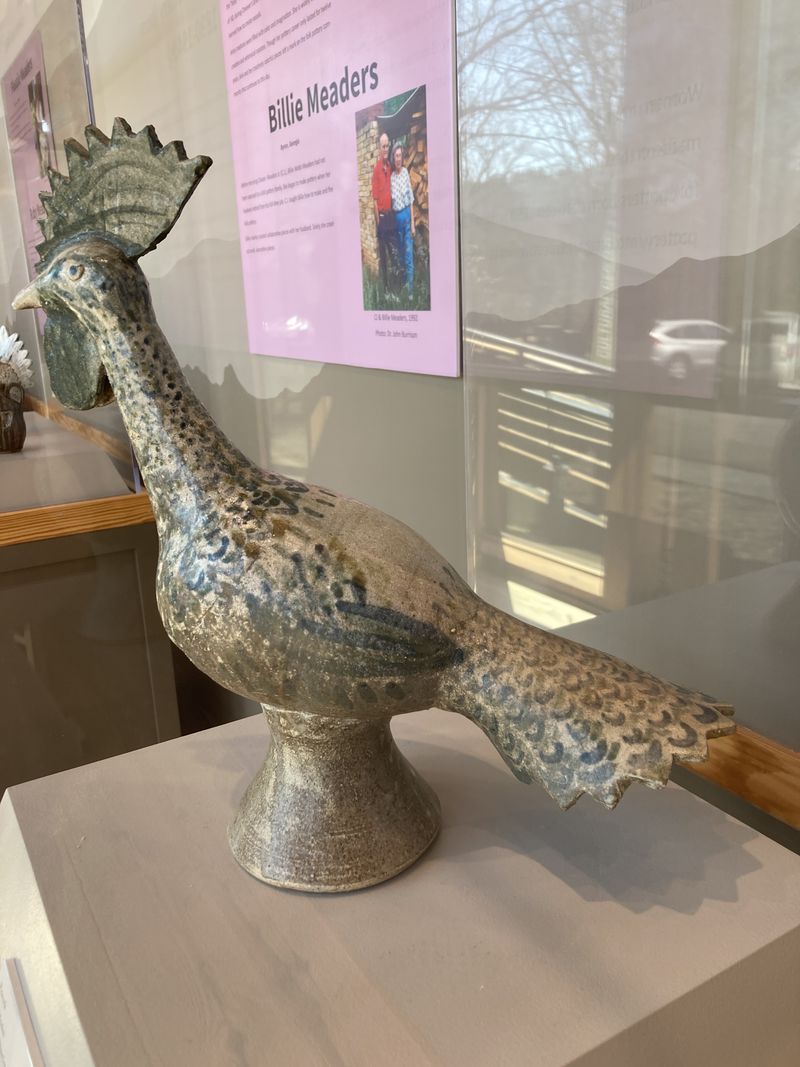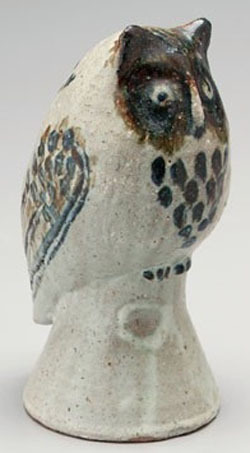
The Meaders name is well-known in North Georgia as possibly the most influential family in the history of Southern Appalachian folk pottery. They were featured in the 1937 book, Handicrafts of the Southern Highlands. They were also honored at the Library of Congress in 1978 when a documentary about their family by the Smithsonian Institute was debuted. And, they were one of the first families in which females took up the art of folk pottery. Arie Meaders, wife to Cheever Meaders, was one of the first and her unique artistic contributions have led to her being considered as the grand dame of folk pottery.
The Meaders’ family history
The family had a struggling farm located in Mossy Creek in a five-mile square of land that was rich with clay for pottery. In 1892, patriarch John M. Meaders saw how other families in the small area were making money by selling hand-crafted jugs and churns. In fact, over a period of fifty years, some had even built “jug manufacturies” to mass produce jugs for moonshine and food storage. At one point, there were at least a dozen pottery shops in the five-mile square. Meaders decided to try pottery as a way to bring in additional money to the farm. He and his three oldest sons set out to build a pottery “ware” shop and kiln. It was all completed by 1893.
Although Meaders didn’t personally take to the craft, his sons did. Meaders had already been taking a wagon to other towns to trade farm produce for chickens. After his sons began producing jugs and churns that were sellable, Meaders used his wagon to take their pieces to places like Athens, Atlanta and Asheville to trade.

All but one of Meaders’ sons took up pottery, most leaving and creating their own shops as they became adults. His youngest son, Cheever, who had become a proficient potter by the age of 14, didn’t move away from the farm, even after he married Arie Waldrop and had eight children with her. At his father’s death, Cheever inherited the Meaders farm and pottery business. Cheever went on to train his four sons in the business. However, as the economy changed and the United States fought a war in Europe, turning pottery became less profitable. Eventually, all of Cheever’s sons left the farm. All four–John, Reggie, Lanier and Edwin–continued to create pottery throughout their lives. While Lanier is probably the best known, all four are known for their work.
Cheever Meaders continued with his pottery business, becoming nationally known for his work. He didn’t stop creating pottery until he retired at the age of 70. However, challenged by wife Arie’s taking up pottery after his retirement, Cheever again took up his work at the turning wheel and kept at it until shortly before his death.
Arie Meaders’ creates her own kind of pottery
Arie Meaders spent most of her life taking care of her family and the house, and doing chores on the farm. After Cheever took up the family business of pottery six years into their marriage, Arie also helped do some of the general labor to keep the pottery business going. However, the craft of pottery was completely dominated by men who passed their skills and knowledge on to their sons. She had no possibility to find her own artistic expression through pottery.
That was the case . . . until Cheever walked away from the business at the age of 70. By that time, all of his sons had moved on from the farm and the business. So, with the work area standing empty, Arie went out one evening after dinner, sat down at the wheel and tried her hand at creating something. She was 60 years old at the time. In an interview for the Smithsonian Institute’s documentary on the family, she recalled that she had little to lose at the time: “I just got to wanting to so bad, I just tried it.” It took three days of trial and error before she began to see a piece of pottery emerge on the wheel.
Arie remembered how Cheever and their Son Lanier would sneak out to the ware shop to see what she was doing: “They decided to watch me and see what I’s a-doing. So Cheever and Lanier both come up there and peeped into the window to see. I don’t know what they thought, they didn’t say nothing and I didn’t say nothing. I didn’t care. And from then on I just kept on working on the wheel and making little pieces and getting little bigger and little bigger and got to where I could make a pretty good piece.”
When Cheever went back to his pottery wheel after Arie got started, he built Arie a turning wheel in the back room of the ware shop for her use. He did not give her help or training along the way, but generally left her on her own to develop her craft. She remembers him offering advice only once. She shared that she was having trouble getting each piece off the wheel without the piece cracking on the bottom. After multiple attempts, Cheever finally offered the key to removing the piece intact–by sliding a wire across the bottom of the piece as it spun on the wheel. It was the only help she received from him.
Over time, Arie worked at developing her own glazes and oxide paints and designing her pieces. Unlike Cheever, Arie designed each piece on paper first and then worked to bring that design to life. She spent time practicing with paints, and creating art pieces like grapes and leaves to adorn each piece. As she told the interviewer, “[Cheever] could not make the things I could vision in my mind.” She was willing to experiment with processes and glazes that traditional potters had not tried. Arie stated that her goal was to create pieces “that combined significant elements of the old and the new.”
Arie called her pieces “art pottery,” decorating with feminine things like morning glories and dogwood blossoms. Arie created pieces that could be used in the kitchen, such as platters, and sugar bowls and jelly jars with lids. She also created whimsical pieces like colorful roosters, pheasants, quail, chickens and owls.
Lanier described Arie’s distinctive style, stating, “The kind of stuff she makes isn’t made anywhere else in the world. And there ain’t anything that can be compared to it.” Possibly because of this uniqueness, Arie’s pieces have resonated with collectors and are still collectible today. For example, her four-piece cannister set with lids sold for just under $6,500 a few years ago.
Arie spent thirteen years working on her craft. After she retired, both she and son Lanier were honored for their pottery by the Library of Congress in 1978.
Meaders’ children continued the family’s legacy

All four of Cheever’s sons–John, Reggie, Lanier and Edwin–and their sister Ruby created pottery throughout their lives. While Lanier is probably the best known, the other siblings are also known for their work. The impact of their parent’s artistic style can be seen in their work.
Of the brothers, the eldest John Rufus died in 1999 after a short illness. He was 82. John’s widow Mildred took up pottery after he died. She was forty at the time.
Reggie died in 2009 at the age of 90. He had worked with pottery for his entire life. Reggie’s wife Flossie was also a potter.
Edwin “Nub” Meaders died in 2015 at the age of 98. He worked at his pottery for 47 years.
Ruby Meaders’ work is on display at the Folk Pottery Museum of Northeast Georgia.
Lanier died in 1998 after a long bout with bone cancer at the age of 71. Lanier practiced his pottery full-time for 1967. During his lifetime, he was awarded the National Heritage Fellowship by the National Endowment for the Arts in 1983 and the Governor’s Awarenesses for the Arts in 1987. Lanier’s face jugs are part of the folk pottery exhibit at the Smithsonian Institute and at the Georgia’s State Art Collection. Lanier was known world-wide for his unique face jugs and is possibly the most famous folk potter in the United States..
Lanier described his passion for his work this way:

“Well, it’s a trade. It’s a gift that a person come by. I could no more stop this than I could fly an airplane. I’m just into it. I’m not going to stop it, can’t stop it. I reckon I’m just supposed to do this. All of my movements, all of my work that I’ve done all my life has led straight to this place right here. And every time I come about it, I get just a little bit deeper into it. I’m about so deep in it now that I can’t get away from it.”
His sentiment must have been shared by all the Meaders’ potters.









